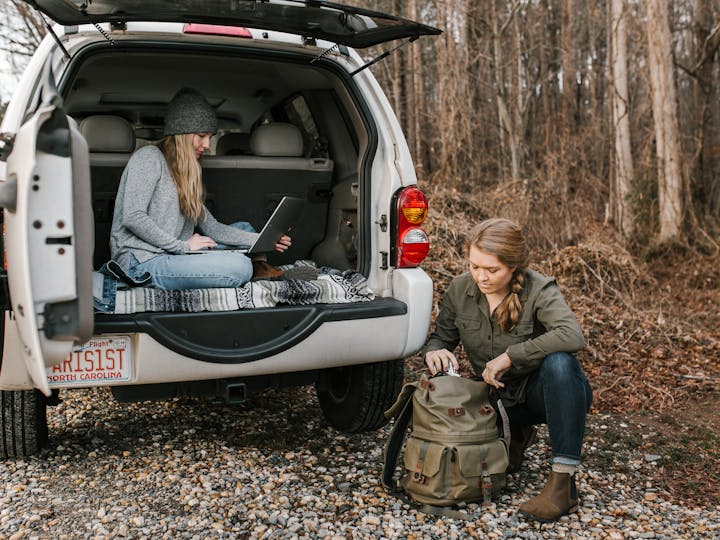The open road has a way of clarifying what matters. At first, it’s the thrill—packing light, chasing warmth, waking up somewhere new. But after months or years of movement, some nomads start to crave something else. Not a mortgage. Not a picket fence. Just a place to exhale.
This shift doesn’t mean giving up the values that sparked the lifestyle. It’s about reimagining what home can look like when freedom is still the priority. The challenge is finding a way to land without getting stuck—something flexible, intentional, and grounded in the same self-reliance that initially made vanlife so appealing.
For modern nomads ready to pause, without giving up the spirit of motion, there’s a growing world of creative alternatives.
The Modern Nomad’s Dilemma: Freedom vs. Foundation
There’s a moment that sneaks up quietly. Maybe it’s your hundredth coffee brewed on a camp stove or the third stormy night in a Walmart parking lot. What once felt like pure freedom starts to wear thin—every decision weighed by distance, every comfort sacrificed for the sake of movement.
That isn’t a failure of the lifestyle. It’s its natural arc. The same restlessness that sent you out into the world might eventually steer you toward something slower, more settled.
But most nomads don’t want to swap mobility for a mortgage. They’re not interested in long-term contracts or cookie-cutter living. What they want is a middle ground—something that preserves autonomy while offering a touch of permanence. A place to build a garden, leave a few books on a shelf, maybe even stay through winter.
Redefining “Settling Down”
For many, settling down sounds like giving in—a slow slide into routine, responsibility, and everything you once left behind. However, when you strip away the assumptions, it doesn’t mean accepting someone else’s version of security.
It can mean designing a space that reflects the person you’ve become after life on the road—resourceful, intentional, a little scrappy. It can mean choosing stillness, for a season or two. The difference is that this kind of home isn’t automatic. It’s deliberate.
Alternative living opens up that possibility. Instead of slotting into a system, you create your own blueprint—one that values low impact, high function, and a view that makes sense to you, not a zoning committee.
Exploring Alternative Living Spaces
Stepping away from the road doesn’t have to mean buying into the traditional housing model. For nomads seeking comfort and creativity without losing their edge, there are plenty of options.
Yurts bring natural materials and open space together in a circular design that feels intentional and calming. They offer seasonal simplicity that pairs well with slow living.
Shipping containers, repurposed as homes, are solid, efficient, and endlessly customizable—ideal for people who want something compact but strong.
Tiny homes on wheels remain a favorite for those who want better insulation, storage, and design than a van offers, while still retaining the mobility of a vehicle.
Then there are park model homes—a rising favorite among those ready for something more rooted. These compact, cabin-style dwellings are built for full-time living. With real kitchens, smart layouts, and a sense of permanence without excess, they offer a striking balance between minimalism and comfort. For nomads ready to pause without giving up their principles, they’re a compelling next chapter.
Building a Home That Moves With You (Even If It Stays Put)
After years of motion, it’s easy to forget the rhythm of a still space. A place where your routines don’t rely on campground availability or fuel range. But the appeal of a stable home base isn’t about surrender—it’s about rest.
Many nomads who choose something more permanent aren’t abandoning freedom—they’re deepening it. As the Tiny Home Industry Association explains, the draw of tiny living isn’t just about saving space. It’s about agency. From cutting costs to reducing environmental impact, the decision to live small often stems from living with intention, not obligation.
Whether it’s a yurt in the woods, a container home on the edge of town, or a tiny cabin with just enough room to stretch out, this shift isn’t about replicating the suburbs. It’s about building something that finally fits.
Making the Leap: What to Consider
Choosing to stay still for a while is less about settling down and more about adjusting your pace. It’s not “Should I stop moving?”—it’s “What kind of movement feels right now?” For some, the answer is still short-term stays, seasonal work, and a loose itinerary. For others, it’s a long-overdue basecamp—somewhere to rest, grow, or start over.
The logistics matter: zoning, utilities, land access, and personal priorities. Whether it’s a tiny house in a clearing or a small structure tucked behind a friend’s property, the point isn’t permanence. It’s permission to rest, to stay, to choose differently.
If you’re not ready to plant roots just yet, this guide to 30 short-term stay strategies can help extend the adventure. But if the road is starting to feel more like a loop than a journey, maybe it’s time to let stillness lead for a while.
Conclusion
Freedom takes different forms. Sometimes it’s a backpack and a border crossing. Sometimes it’s a quiet morning and a front step. Choosing to pause—even briefly—doesn’t mean you’ve lost your edge. It just means you’ve found a new rhythm.
For modern nomads, home isn’t about permanence. It’s about alignment—building a space that reflects the life you’ve lived and the direction you’re headed. Whether it’s mobile, modular, or fixed to the earth, the right home is the one that lets you keep choosing your path.


